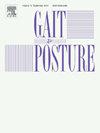Standardizing head movements in gait assessment through augmented reality, a cross-sectional study
IF 2.4
3区 医学
Q3 NEUROSCIENCES
引用次数: 0
Abstract
Background
Head movements challenge human balance during locomotion, but their exact impact remains unclear due to non-standardized experimental setups. This study validates an augmented reality (AR) cueing setup for head movements during gait assessment, investigating its task performance accuracy, hardware impact, ability for standardization and the effects of head movements on gait.
Methods
In this cross-sectional study, 25 healthy adults underwent a 3D-motion capture gait protocol. Participants walked overground under three conditions: 1) auditory-cued head turns wearing a headband, 2) auditory-cued head turns wearing an AR head mounted display (AR-HMD), 3) AR-cued (hologram) head turns wearing AR-HMD. Head kinematics (angles and velocity) and eye movements were recorded during horizontal and vertical head movements. Task performance accuracy was measured as the coherency (gain,%) in head and eye with the hologram. Hardware impact on head kinematics was assessed using linear mixed models. Standardization of an AR-HMD versus traditional auditory cueing was measured by head kinematics variance and kinematic profiles.
Results
Task performance accuracy was high (eyes-hologram: 99.5 ± 0.8 %; head-hologram 98.8 ± 1.6 %). Hardware impacted angular head velocity (p < 0.001) but not range of motion (p = 0.700). Standardization of the head movement was better in AR with lower variances in kinematic profiles, standard deviations (p < 0.05) and coefficients of variance (p > 0.05) compared to auditory cueing.
Conclusion
In conclusion, an AR-HMD setup elicits more standardized head movements shown by lower variance in head kinematics with excellent task performance accuracy. This offers a proof of concept for AR elicited head movements as a method in gait assessment in healthy individuals.
通过增强现实规范步态评估中的头部运动,一项横断面研究
头部运动在运动过程中挑战人类的平衡,但由于非标准化的实验设置,它们的确切影响尚不清楚。本研究验证了增强现实(AR)在步态评估中的头部运动提示设置,研究了其任务执行准确性、硬件影响、标准化能力以及头部运动对步态的影响。在这项横断面研究中,25名健康成年人接受了3d运动捕捉步态方案。参与者在三种情况下在地面上行走:1)戴着头带进行听觉提示的头部转动,2)戴着AR头戴式显示器(AR- hmd)进行听觉提示的头部转动,3)戴着AR头戴式显示器进行AR(全息)提示的头部转动。记录水平和垂直头部运动时的头部运动学(角度和速度)和眼球运动。以头、眼与全息图的相干度(增益,%)衡量任务执行精度。使用线性混合模型评估硬件对头部运动学的影响。AR-HMD与传统听觉提示的标准化通过头部运动学方差和运动学剖面进行测量。结果任务执行准确率高(眼全息图:99.5 ± 0.8 %; head-hologram 98.8±1.6 %)。硬件影响角头速度(p <; 0.001),但不影响运动范围(p = 0.700)。与听觉提示相比,AR的头部运动标准化更好,其运动学曲线、标准差(p <; 0.05)和方差系数(p >; 0.05)的方差更低。结论AR-HMD设置使头部运动更加标准化,头部运动学方差更小,任务执行精度更高。这为AR引发的头部运动作为健康个体步态评估方法提供了概念证明。
本文章由计算机程序翻译,如有差异,请以英文原文为准。
求助全文
约1分钟内获得全文
求助全文
来源期刊

Gait & posture
医学-神经科学
CiteScore
4.70
自引率
12.50%
发文量
616
审稿时长
6 months
期刊介绍:
Gait & Posture is a vehicle for the publication of up-to-date basic and clinical research on all aspects of locomotion and balance.
The topics covered include: Techniques for the measurement of gait and posture, and the standardization of results presentation; Studies of normal and pathological gait; Treatment of gait and postural abnormalities; Biomechanical and theoretical approaches to gait and posture; Mathematical models of joint and muscle mechanics; Neurological and musculoskeletal function in gait and posture; The evolution of upright posture and bipedal locomotion; Adaptations of carrying loads, walking on uneven surfaces, climbing stairs etc; spinal biomechanics only if they are directly related to gait and/or posture and are of general interest to our readers; The effect of aging and development on gait and posture; Psychological and cultural aspects of gait; Patient education.
 求助内容:
求助内容: 应助结果提醒方式:
应助结果提醒方式:


